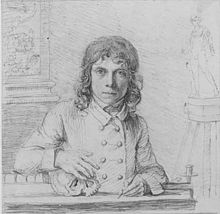John Flaxman
John Flaxman RA (born July 6, 1755 in York , † December 7, 1826 in London ) was a British sculptor and medalist .
Live and act
Flaxman was the son of plasterer John Flaxman. The sculptor William Flaxman was his brother, the painter Mary Ann Flaxman his stepsister. In 1756 Flaxman came to London with his family. There he received his first artistic guidance in his father's workshop. In addition to the very short time at school, this was the entire basis of Flaxman's knowledge.
The sculptor George Romney and the Reverend AS Mathew noticed him because of his talent . Sponsored by both, Flaxmann was able to exhibit some figurines at an exhibition of the Free Society of Arts as early as 1767 . At the age of 15, Flaxman's wax model of a Neptune was awarded a silver medal at an exhibition at the Academy of Arts .
In the same year Flaxman became a member of the academy and very quickly made the acquaintance of Thomas Stothard and William Blake . By his own admission, he learned the most during this time. In 1775 Thomas Bentley recruited him for the Wedgwood company . Josiah Wedgwood hired Flaxman for his porcelain factory " Etruria ".
With Flaxman's designs, Wedgwood's economic boom began. In addition, he found enough opportunities to be artistically active; u. a. he designed tombs for various personalities.
At the age of 27 Flaxman married Ann Denmann in 1782, the marriage remained childless. Five years later, Flaxman, with a generous grant from Wedgwood, went on a study trip to Rome . His wife accompanied him on this trip. In Rome, in 1793, the sculptor made drawings for Homer's Iliad as a commissioned work , which was engraved in copper in 1795 by Tommaso Piroli (1752 or 1750 - 1824). Drawings for the Odyssey followed , engraved by William Blake . These classicist outline drawings established his fame. They set the style for other artists (e.g. the classic illustrations by Moritz Retzsch for Goethe's Faust I).
In the summer of 1794 Flaxman returned from Rome with his wife and settled in London as a freelance artist. In 1797 the Academy appointed him to be its assessor, and three years later he was accepted as a full member. In 1802 Flaxman went to Paris to study . As a member of the Academy, all doors were open to him; a hindrance, however, was a sometimes quite intolerant attitude towards religious matters.
The only thing Flaxman praised in Paris was a drawing by Jean Auguste Dominique Ingres . The academy student had presented him with his picture of Achilles receiving Agamemnon's ambassadors for assessment. Back in London, Flaxman worked for a few years until he was offered a chair in plastic at the London Academy in 1810. The Swiss painter Johann Heinrich Füssli expressly testified to the popularity of Flaxman's lectures and seminars.
In 1796 Flaxman was also involved in poetry. He wrote poems for his wife, which he also illustrated himself. Most of the time he worked as a sculptor. In addition to his colleagues Louis Roubiliac , Sir Francis Chantrey or Richard Westmacott , he was able to hold his own with ease. For the painter George Romney he made many impressions of antiquities on his behalf.
Flaxman died on December 7, 1826 in London at the age of 71.
Works
- The basket. 1797.
- The knight with the blazing cross. 1796.
- La divina commedia di Dante Alighieri: cioè l'inferno, il purgatorio ed il paradiso . Vallardi, Milano 1819. ( digitized version )
- John Flaxman's illustrations for the Odyssey
- John Flaxman's illustrations for the Divine Comedy of Dante
literature
- Werner Hofmann (Ed.): John Flaxman. Mythology and Industry. Prestel, Munich 1979, ISBN 3-7913-0468-2 ( art around 1800 ), (exhibition catalog, Hamburg, Hamburger Kunsthalle, April 20 - May 30, 1979).
- Sarah Symmons: Flaxman and Europe. The Outline Illustrations and their Influence. Garland, New York NY et al. 1984, ISBN 0-8240-5987-5 ( Outstanding Theses from the Courtauld Institute of Art ), (Also: London, Univ., Diss.).
- Sylvie Tritz: John Flaxman and the Renaissance. A master of classicism in dialogue with Masaccio and Donatello. = John Flaxman and the Renaissance. Sculpture Collection and Museum of Byzantine Art - National Museums in Berlin, Berlin 2009, ISBN 978-3-88609-663-3 (exhibition catalog, Berlin, Bode-Museum, April 9 to July 12, 2009).
Web links
- Literature by and about John Flaxman in the catalog of the German National Library
- John Flaxman at artfacts.net
- John Flaxman at artcyclopedia.com (English)
- John Flaxman Collection , University College London Art Museum
Individual evidence
- ^ L. Forrer: Biographical Dictionary of Medallists . Flaxman, John. Volume II. Spink & Son Ltd, London 1904, p. 102 ff .
- ^ L. Forrer: Biographical Dictionary of Medallists . Flaxman, John. Volume VII. Spink & Son Ltd, London 1923, pp. 308 .
- ^ John Flaxman, RA in the database of the Royal Academy of Arts , English, accessed on May 22, 2013.
| personal data | |
|---|---|
| SURNAME | Flaxman, John |
| BRIEF DESCRIPTION | British sculptor |
| DATE OF BIRTH | July 6, 1755 |
| PLACE OF BIRTH | York |
| DATE OF DEATH | December 7, 1826 |
| Place of death | London |


